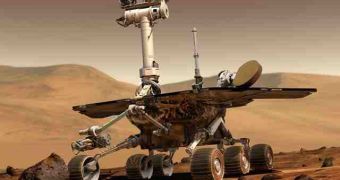Mars' hemispheres are very different in weather and even in season, given the positioning of the planet in relation to the Sun. Since its southern part is now facing the Sun, it is spring time for half of Mars, while the other half gets ready for the closing winter. This also has a big impact on science, because as the Phoenix Mars Lander ultimately froze to death, the two old rovers woke up and started hovering around diametrically opposed areas of the red planet, collecting bits of knowledge.
It seems that Mars is more proper for conducting studies than previously thought, since Phoenix and the rovers have lasted a lot more than they were designed. The mission of Opportunity and Spirit was only estimated to last for three months, but they've been going on for five years. Still, their tasks are made more difficult because of the Martian dust and sand which hinder their movement and prevent them from receiving more sunlight (converted to energy) by covering them.
Spirit left the Home Plate plateau where it hibernated and, after the communication interruption caused by the positioning of the Sun between Mars and the Earth (29 November - 15 December), it will move towards its next targets, the Von Braun hill and the small Goddard crater located almost 300 meters away. Unfortunately, it hasn't managed to shake off the dust covering its solar panels, so it can only generate 240 watt-hours of energy daily, which, during its hibernation, was enough for it to perform scientific measurements of the surroundings.
On the other side, Opportunity left the crater Victoria and started its more than two-year long journey of 12 km that will take it to the larger crater named Endeavour. It was luckier than its counterpart and was able to get rid of the covering layer of dust, now receiving over 600 watt-hours of energy daily, thus moving faster (about 100 meters each hour). It is important that the rovers do not get trapped in sand, as it happened to Opportunity in April 2005, when it got stuck in the 30-centimeter high “Purgatory Dune” for five weeks. During its trek, Opportunity will perform analyses of some rock formations it encounters, but not too many, since measurements take about five days per rock.

 14 DAY TRIAL //
14 DAY TRIAL //